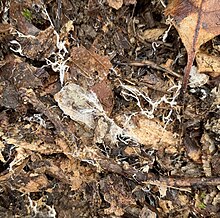
Back شبكات المايكورهيزال Arabic Mykorrhiza-netværk Danish Wood Wide Web Estonian Réseau mycorhizien French Rete micorrizica Italian 우드 와이드 웹 Korean Sieci mykoryzowe Polish Wood World Web Portuguese Mykorrhizanätverk Swedish 菌根网络 Chinese
This article's factual accuracy is disputed. (May 2023) |


A mycorrhizal network (also known as a common mycorrhizal network or CMN) is an underground network found in forests and other plant communities, created by the hyphae of mycorrhizal fungi joining with plant roots. This network connects individual plants together. Mycorrhizal relationships are most commonly mutualistic, with both partners benefiting, but can be commensal or parasitic, and a single partnership may change between any of the three types of symbiosis at different times.[1]
The formation and nature of these networks is context-dependent, and can be influenced by factors such as soil fertility, resource availability, host or mycosymbiont genotype, disturbance and seasonal variation.[2] Some plant species, such as buckhorn plantain, a common lawn and agricultural weed, benefit from mycorrhizal relationships in conditions of low soil fertility, but are harmed in higher soil fertility.[3] Both plants and fungi associate with multiple symbiotic partners at once, and both plants and fungi are capable of preferentially allocating resources to one partner over another.[4]
Mycorrhizal associations have profoundly impacted the evolution of plant life on Earth ever since the initial adaptation of plant life to land. In evolutionary biology, mycorrhizal symbiosis has prompted inquiries into the possibility that symbiosis, not competition, is the main driver of evolution.[5]
Referencing an analogous function served by the World Wide Web in human communities, the many roles that mycorrhizal networks appear to play in woodland have earned them a colloquial nickname: the Wood Wide Web.[6][7] Many of the claims made about common mycorrhizal networks, including that they are ubiquitous in forests, that resources are transferred between plants through them, and that they are used to transfer warnings between trees, have been criticised as being not strongly supported by evidence.[8][9][10]
- ^ Allen, Michael F. (January 2003), "Mycorrhizae: Arbuscular Mycorrhizae", Encyclopedia of Environmental Microbiology, Hoboken, New Jersey: John Wiley & Sons, Inc., doi:10.1002/0471263397.env207, ISBN 0471263397, retrieved 29 May 2022
- ^ Cite error: The named reference
Simard2012was invoked but never defined (see the help page). - ^ Cite error: The named reference
vanderHeijden2009was invoked but never defined (see the help page). - ^ Werner, Gijsbert; Kiers, E. Toby (2015). "Partner selection in the mycorrhizal mutualism". The New Phytologist. 205 (4): 1437–1442. doi:10.1111/nph.13113. PMID 25421912.
- ^ Yihdego, David (2017). "Food, Poison, and Espionage: Mycorrhizal Networks in Action". Arnold. 75 (2): 10–11.
- ^ Giovannetti, Manuela; Avio, Luciano; Fortuna, Paola; Pellegrino, Elisa; Sbrana, Cristiana; Strani, Patrizia (2006). "At the Root of the Wood Wide Web". Plant Signaling & Behavior. 1 (1): 1–5. Bibcode:2006PlSiB...1....1G. doi:10.4161/psb.1.1.2277. PMC 2633692. PMID 19521468.
- ^ Macfarlane, Robert (7 August 2016). "The Secrets of the Wood Wide Web". The New Yorker. USA. Retrieved 21 November 2018.
- ^ Karst, Justine; Jones, Melanie D.; Hoeksema, Jason D. (2023-02-13). "Positive citation bias and overinterpreted results lead to misinformation on common mycorrhizal networks in forests". Nature Ecology & Evolution. 7 (4): 501–511. Bibcode:2023NatEE...7..501K. doi:10.1038/s41559-023-01986-1. ISSN 2397-334X. PMID 36782032. S2CID 256845005.
- ^ "Where the 'Wood-Wide Web' Narrative Went Wrong". Undark Magazine. 2023-05-25. Retrieved 2023-06-17.
- ^ Henriksson, Nils; Marshall, John; Högberg, Mona N.; Högberg, Peter; Polle, Andrea; Franklin, Oskar; Näsholm, Torgny (July 2023). "Re-examining the evidence for the mother tree hypothesis – resource sharing among trees via ectomycorrhizal networks". New Phytologist. 239 (1): 19–28. doi:10.1111/nph.18935. ISSN 0028-646X. PMID 37149889. S2CID 258558216.